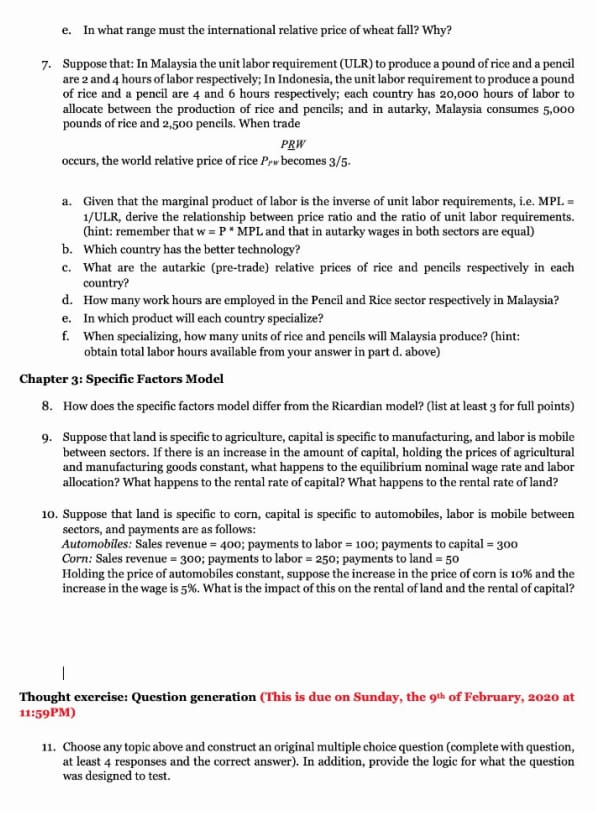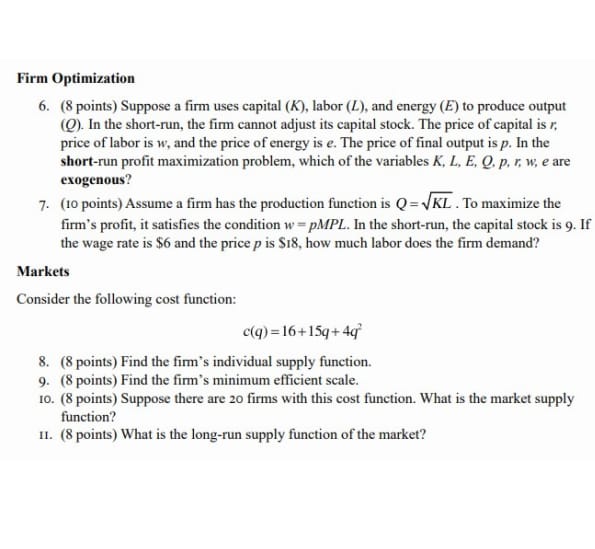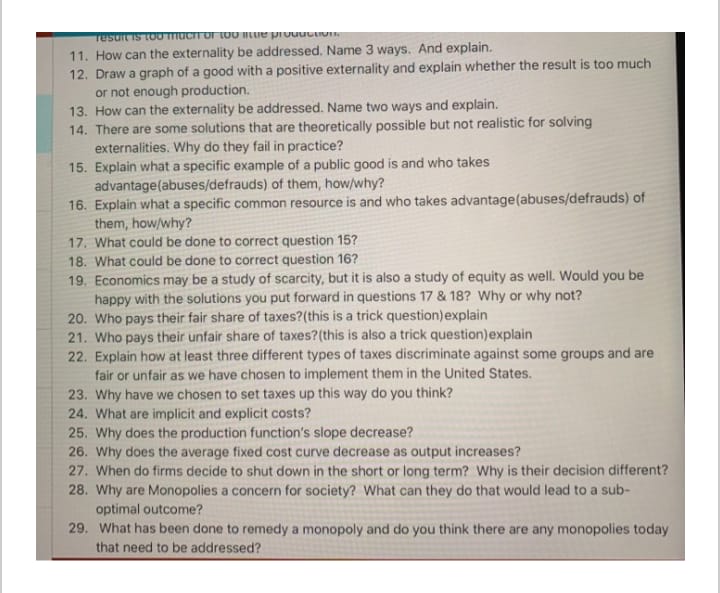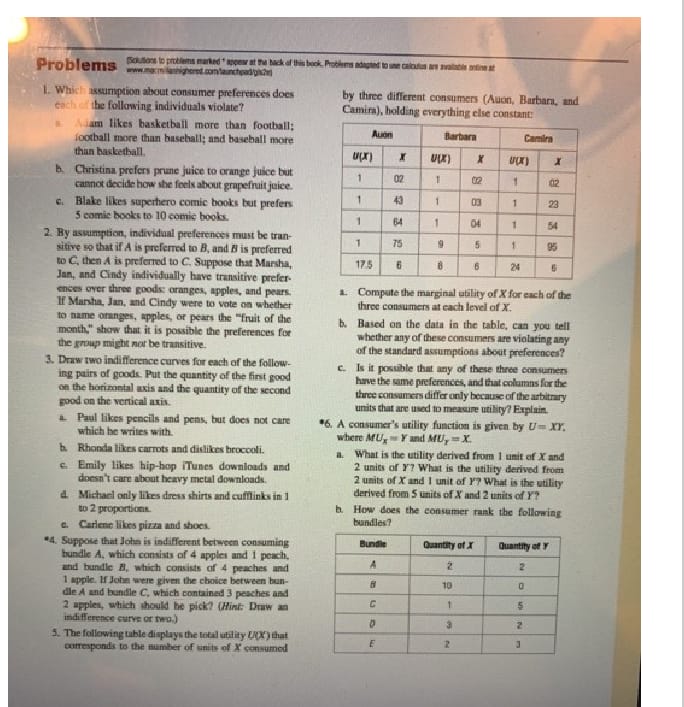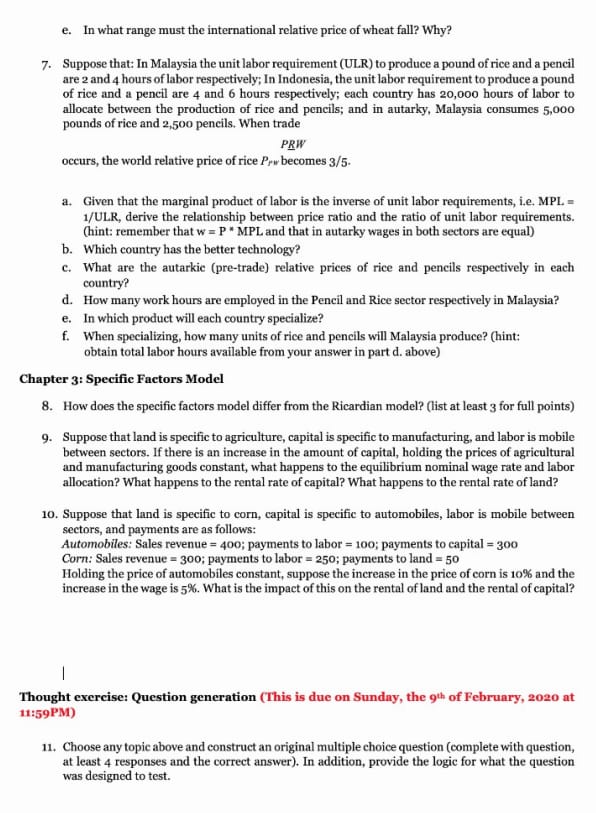
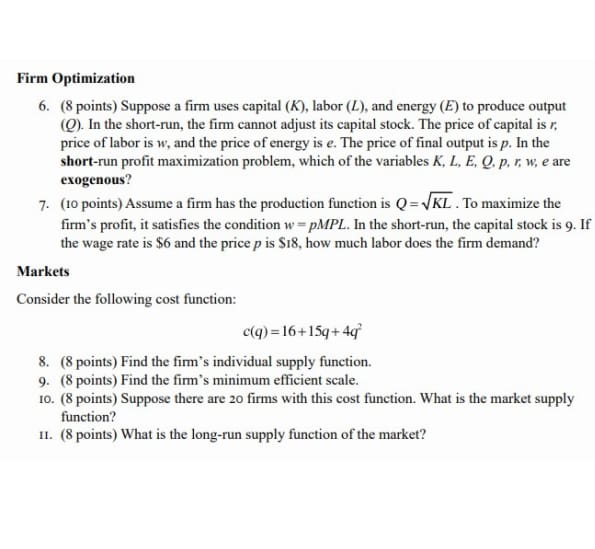
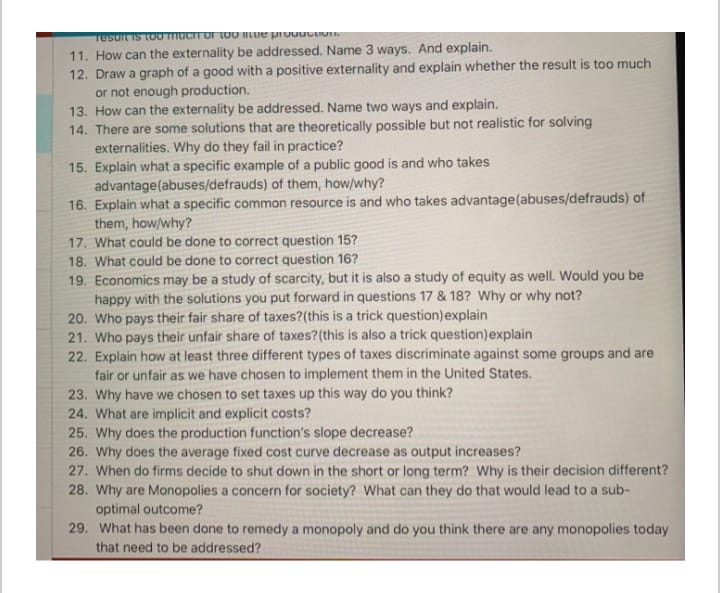
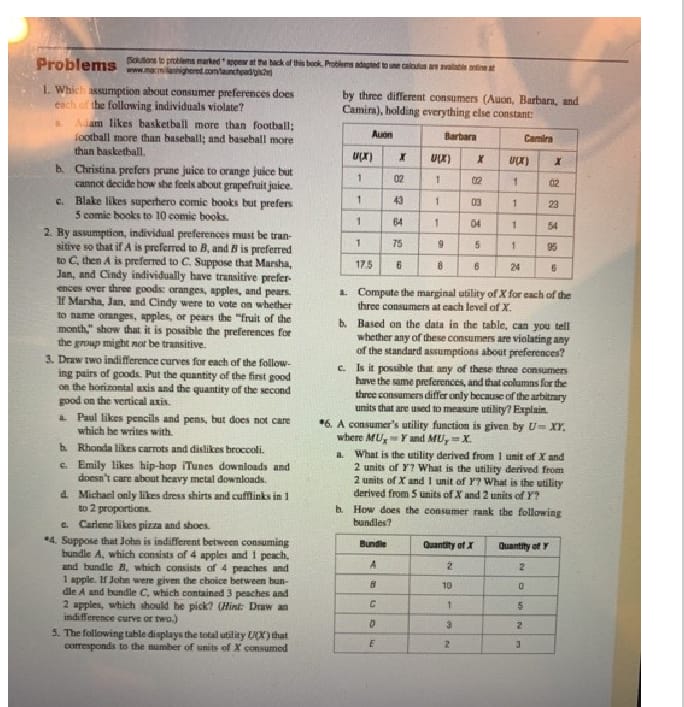
Provide solutions to the problems.
e. In what range must the international relative price of wheat fall? Why? 7. Suppose that: In Malaysia the unit labor requirement (ULR) to produce a pound of rice and a pencil are 2 and 4 hours of labor respectively; In Indonesia, the unit labor requirement to produce a pound of rice and a pencil are 4 and 6 hours respectively; each country has 20,000 hours of labor to allocate between the production of rice and pencils; and in autarky, Malaysia consumes 5,000 pounds of rice and 2,500 pencils. When trade PRW occurs, the world relative price of rice Pew becomes 3/5- a. Given that the marginal product of labor is the inverse of unit labor requirements, i.e. MPL = 1/ULR, derive the relationship between price ratio and the ratio of unit labor requirements. (hint: remember that w = P * MPL and that in autarky wages in both sectors are equal) b. Which country has the better technology? c. What are the autarkie (pre-trade) relative prices of rice and pencils respectively in each country? d. How many work hours are employed in the Pencil and Rice sector respectively in Malaysia? e. In which product will each country specialize? f. When specializing, how many units of rice and pencils will Malaysia produce? (hint: obtain total labor hours available from your answer in part d. above) Chapter 3: Specific Factors Model 8. How does the specific factors model differ from the Ricardian model? (list at least 3 for full points) 9. Suppose that land is specific to agriculture, capital is specific to manufacturing, and labor is mobile between sectors. If there is an increase in the amount of capital, holding the prices of agricultural and manufacturing goods constant, what happens to the equilibrium nominal wage rate and labor allocation? What happens to the rental rate of capital? What happens to the rental rate of land? 10. Suppose that land is specific to corn, capital is specific to automobiles, labor is mobile between sectors, and payments are as follows: Automobiles: Sales revenue = 400; payments to labor = 100; payments to capital = 300 Corn: Sales revenue = 300; payments to labor = 250; payments to land = 50 Holding the price of automobiles constant, suppose the increase in the price of corn is 10% and the increase in the wage is 5%. What is the impact of this on the rental of land and the rental of capital? Thought exercise: Question generation (This is due on Sunday, the gth of February, 2020 at 11:59PM) 11. Choose any topic above and construct an original multiple choice question (complete with question, at least 4 responses and the correct answer). In addition, provide the logic for what the question was designed to test.Firm Optimization 6. (8 points) Suppose a firm uses capital (X), labor (Z), and energy (E) to produce output (). In the short-run, the firm cannot adjust its capital stock. The price of capital is r. price of labor is w, and the price of energy is e. The price of final output is p. In the short-run profit maximization problem, which of the variables K. L. E. O. p, r, w, e are exogenous? 7. (10 points) Assume a firm has the production function is Q=KL . To maximize the firm's profit, it satisfies the condition w = pMPL. In the short-run, the capital stock is 9. If the wage rate is $6 and the price p is $18, how much labor does the firm demand? Markets Consider the following cost function: c(q) =16+15q+4q 8. (8 points) Find the firm's individual supply function. 9. (8 points) Find the firm's minimum efficient scale. 10. (8 points) Suppose there are 20 firms with this cost function. What is the market supply function? II. (8 points) What is the long-run supply function of the market?TOSUIT IS TOU THOCITOI WY IIQUE PIVUUGAIN 11. How can the externality be addressed. Name 3 ways. And explain. 12. Draw a graph of a good with a positive externality and explain whether the result is too much or not enough production. 13. How can the externality be addressed. Name two ways and explain. 14. There are some solutions that are theoretically possible but not realistic for solving externalities. Why do they fail in practice? 15. Explain what a specific example of a public good is and who takes advantage(abuses/defrauds) of them, how/why? 16. Explain what a specific common resource is and who takes advantage(abuses/defrauds) of them, how/why? 17. What could be done to correct question 15? 18. What could be done to correct question 16? 19, Economics may be a study of scarcity, but it is also a study of equity as well. Would you be happy with the solutions you put forward in questions 17 & 18? Why or why not? 20. Who pays their fair share of taxes?(this is a trick question) explain 21. Who pays their unfair share of taxes?(this is also a trick question)explain 22. Explain how at least three different types of taxes discriminate against some groups and are fair or unfair as we have chosen to implement them in the United States. 23. Why have we chosen to set taxes up this way do you think? 24. What are implicit and explicit costs? 25. Why does the production function's slope decrease? 26. Why does the average fixed cost curve decrease as output increases? 27. When do firms decide to shut down in the short or long term? Why is their decision different? 28. Why are Monopolies a concern for society? What can they do that would lead to a sub- optimal outcome? 29. What has been done to remedy a monopoly and do you think there are any monopolies today that need to be addressed?Problems 1. Which assumption about consumer preferences does by three different consumers (Augin, Barbara, and each of the following individuals violate? Camina), holding everything else constant Ajam likes basketball more than football; football more than baschall; and baseball more than basketball B. Christina prefers prune juice to orange juice but cannot decide how the fools about grapefruit juice Blake likes superhero comic books but prefers 5 comic books to 10 comic books. 2. By assumption, individual preferences must be tran- sitive so that if A is preferred to B, and B is preferred to C. then A is preferred to C. Suppose that Marsha, 174 24 Jan, and Cindy individually have transitive prefer ences over three goods oranges, apples, and pears. Compute the marginal utility of X for each of the If Marsha, Jan, and Cindy were to vote on whether three consumer at each level of X. to name oranges, apples, or pears the "fruit of the Based on the data in the table, can you tell month." show that it is possible the preferences for whether any of these consumers ire violating any the proup might not be transitive. of the standard assumptions about preferences? 3. Draw two indifference curves for each of the follow- Is it possible that any of these three consumer ing pairs of goods. Put the quantity of the first good have the same preferences, and that columns for the on the horizontal axis and the quantity of the second face consumers differ only because of the arbitrary good on the vertical axis. units that and used to measure utility? Explain Paul likes pencils and pens, but does not care "6. A consumer's utility function is given by Um Xr. which he writes with. Where AfU - Y and MUT=X b. Rhonda likes carrots and dislikes broccoli. What is the utility derived from I unit of X and Emily likes hip-hop iTunes downloads and 2 units of 17 What is the utility derived from docan't care about heavy metal downloads. 2 units of X and I unit of 17 What is the utility Michael only likes dress shirts and cufflinks in 1 derived from $ units of X and 2 units of Y? 10 2 proportions How does the consumer rank the following . Carlene likes pizza and shoes. bundles? "4. Suppose that John is ind ferent between consuming Burdit Quantity of I Quantity of bundle A. which consists of 4 apples and I peach. and bundle I, which consists of 4 peaches and 2 1 apple. If John were given the choice between bun- 10 ile A and bundle C, which contained 3 peaches and 2 apples, which should be pick? (Hint Draw an 1 indifference curve or two,) a 3. The following table displays the total utility (NX ) that corresponds to the number of units of &' consumed




